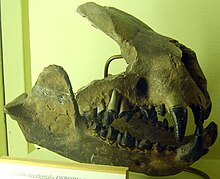Palaeonictinae
| Palaeonictinae | |
|---|---|
 | |
| skull of Palaeonictis occidentalis | |
 | |
| parts of lower jaw of Ambloctonus sinosus | |
| Scientific classification | |
| Domain: | Eukaryota |
| Kingdom: | Animalia |
| Phylum: | Chordata |
| Class: | Mammalia |
| Clade: | Pan-Carnivora |
| Order: | †Oxyaenodonta |
| Family: | †Oxyaenidae |
| Subfamily: | †Palaeonictinae Denison, 1938[1] |
| Type genus | |
| †Palaeonictis de Blainville, 1842 | |
| Genera | |
| |
| Synonyms | |
Palaeonictinae ("ancient weasels") is an extinct subfamily of placental mammals from extinct family Oxyaenidae, that lived from the late Paleocene to early Eocene of Europe and North America.[7][8][9]
Classification and phylogeny[edit]
Taxonomy[edit]
- Subfamily: †Palaeonictinae (Denison, 1938)
- Genus: †Ambloctonus (Cope, 1875)
- †Ambloctonus major (Denison, 1938)
- †Ambloctonus priscus (Matthew & Granger, 1915)
- †Ambloctonus sinosus (Cope, 1875)
- Genus: †Dipsalodon (paraphyletic genus) (Jepsen, 1930)
- †Dipsalodon churchillorum (Rose, 1981)
- †Dipsalodon matthewi (Jepsen, 1930)
- Genus: †Palaeonictis (de Blainville, 1842)
- †Palaeonictis gigantea (de Blainville, 1842)
- †Palaeonictis occidentalis (Osborn, 1892)
- †Palaeonictis peloria (Rose, 1981)
- †Palaeonictis wingi (Chester, 2010)
- Genus: †Ambloctonus (Cope, 1875)
References[edit]
- ^ R. H. Denison (1938) "The broad-skulled Pseudocreodi." Annals of the New York Academy of Sciences 37:163-256
- ^ Floréal Solé; Bernard Marandat; Fabrice Lihoreau (2020). "The hyaenodonts (Mammalia) from the French locality of Aumelas (Hérault), with possible new representatives from the late Ypresian". Geodiversitas. 42 (13): 185–214. doi:10.5252/geodiversitas2020v42a13. S2CID 219585388.
- ^ E. D. Cope (1877) "Report upon the extinct Vertebrata obtained in New Mexico by parties of the expedition of 1874." Report upon United States Geographical Surveys West of the One Hundredth Meridian, in charge of First Lieut. G.M. Wheeler, Corps of Engineers, U.S. Army, Vol. IV Paleontology, Part II, pp. 1–365. Government Printing Office, Washington, D.C.
- ^ Gregory, W. K. and Hellman, H. (1939) "On the evolution and major classification of the civets (Viverridae) and allied fossil and recent Carnivora; a phylogenetic study of the skull and dentition." Proceedings of the American Philosophical Society, 81, 309–92
- ^ Haeckel, Ernst (1895). Systematische Phylogenie: Wirbelthiere (in German). Vol. T.3. Berlin: G. Reimer.
- ^ Osborn, H. F. (1892) "Taxonomy and morphology of the primates, creodonts, and ungulates." In: "Fossil mammals of the Wahsatch and Wind River beds. Collection of 1891." (H. F. Osborn and J. L. Wortman), Bull. Amer. Mus. Nat. Hist., 4: 81-147
- ^ Gunnel, Gregg F.; Gingerich, Philip D. (1991). "Systematics and evolution of late Paleocene and early Eocene Oxyaenidae (Mammalia, Creodonta) in the Clarks Fork Basin, Wyoming" (PDF). Contributions from the Museum of Paleontology. 28 (7). The University of Michigan: 141–180.
- ^ McKenna, Malcolm C.; Bell, Susan K. (1997). Classification of Mammals Above the Species Level. New York: Columbia University Press. ISBN 978-0-231-11012-9. Retrieved 16 March 2015.
- ^ Stephen G. B. Chester; Jonathan I. Bloch; Ross Secord; Doug M. Boyer (2010). "A new small bodied species of Palaeonictis (Creodonta, Oxyaenidae) from the Paleocene-Eocene thermal maximum". Journal of Mammalian Evolution. 17 (4): 227–243. doi:10.1007/s10914-010-9141-y. S2CID 15058311.


 French
French Deutsch
Deutsch